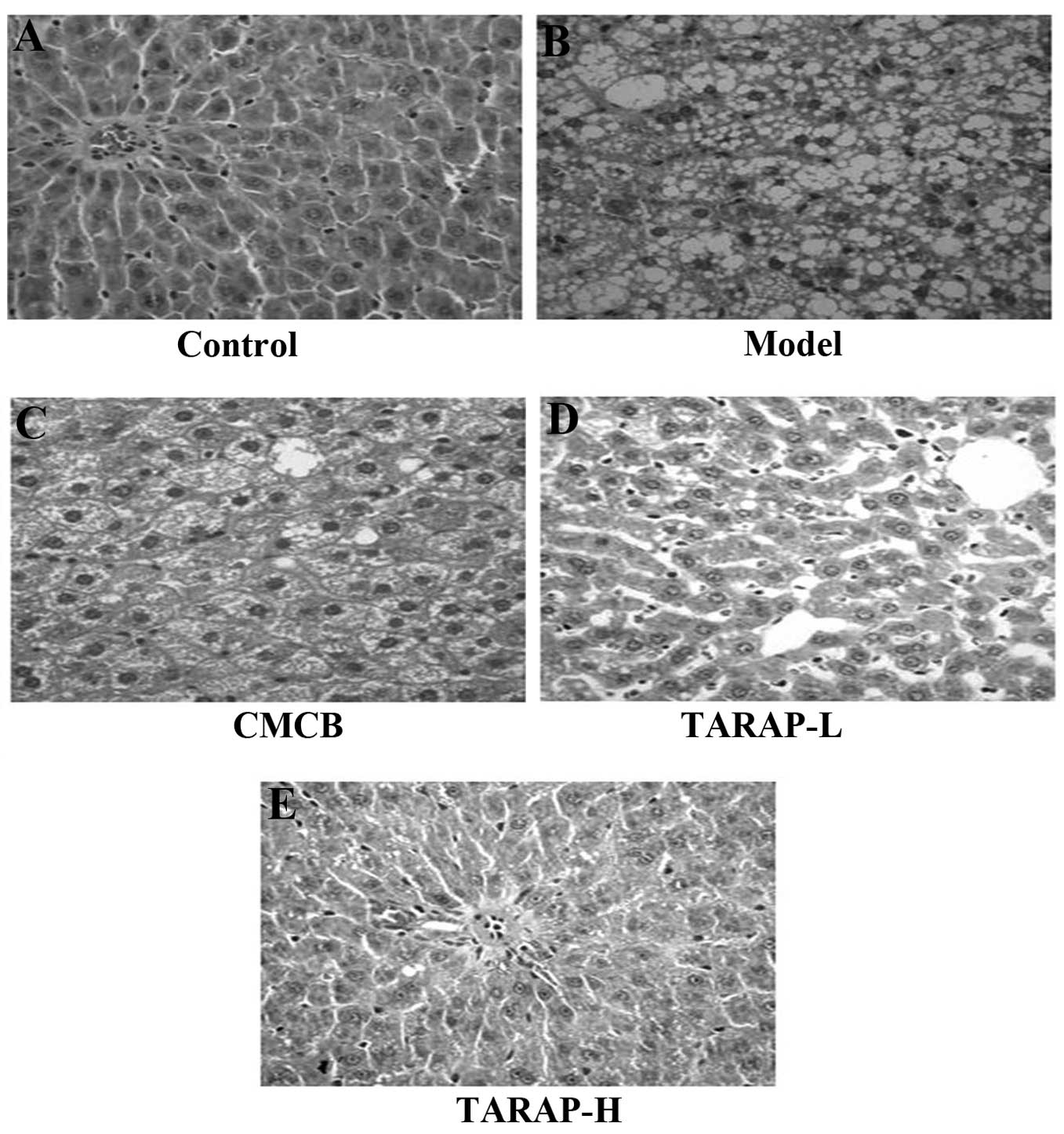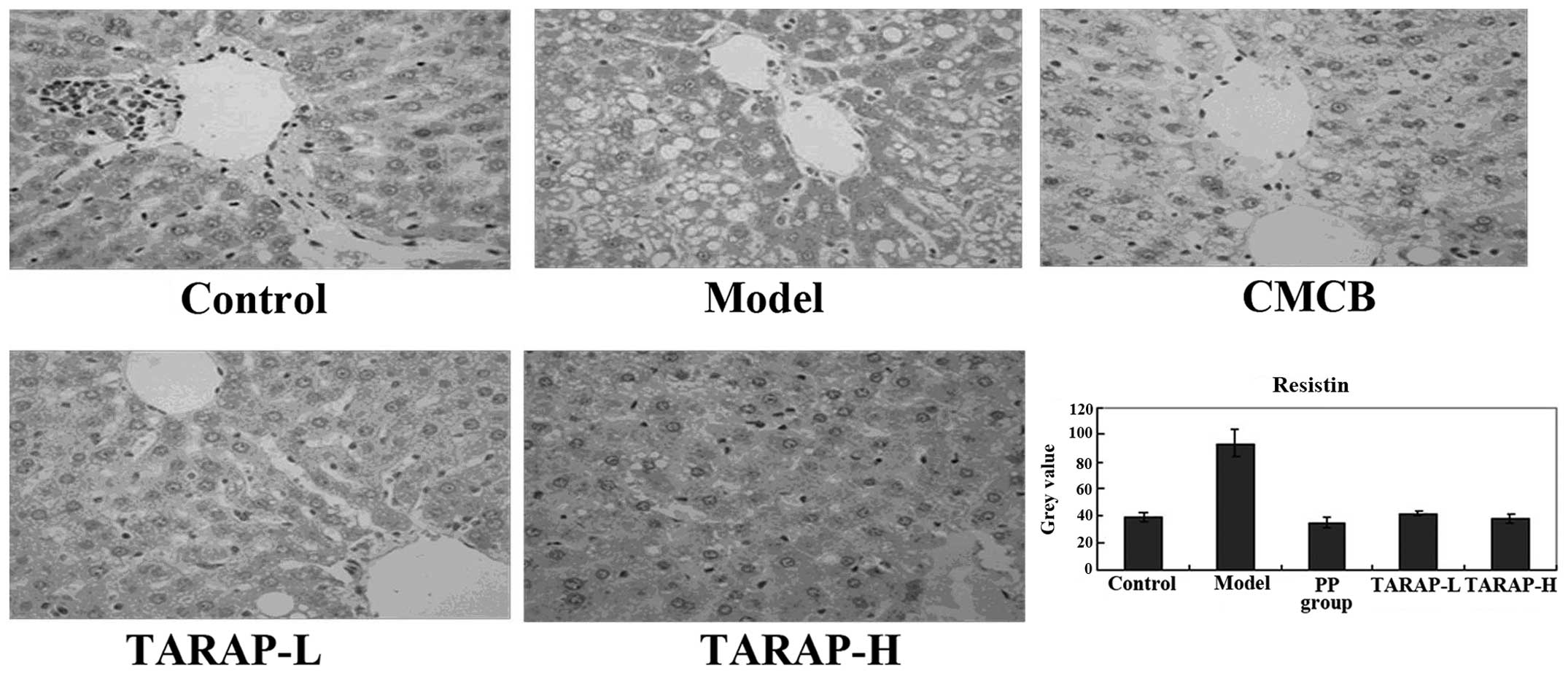|
1
|
Fan JG and Farrell GC: Epidemiology of
non-alcoholic fatty liver disease in China. J Hepatol. 50:204–210.
2009. View Article : Google Scholar : PubMed/NCBI
|
|
2
|
Everhart JE and Bambha KM: Fatty liver:
think globally. Hepatology. 51:1491–1493. 2010. View Article : Google Scholar : PubMed/NCBI
|
|
3
|
Bruce KD and Byrne CD: The metabolic
syndrome: common origins of a multifactorial disorder. Postgraduate
Med J. 85:614–621. 2009. View Article : Google Scholar : PubMed/NCBI
|
|
4
|
Malaguarnera M, Di Rosa M, Nicoletti F and
Malaguarnera L: Molecular mechanisms involved in NAFLD progression.
J Mol Med (Berl). 87:679–695. 2009. View Article : Google Scholar : PubMed/NCBI
|
|
5
|
Adams LA, Angulo P and Lindor KD:
Nonalcoholic fatty liver disease. CMAJ. 172:899–905. 2005.
View Article : Google Scholar : PubMed/NCBI
|
|
6
|
Day CP and James OF: Steatohepatitis: a
tale of two ‘hits’? Gastroenterology. 114:842–845. 1998.
|
|
7
|
Guzman G, Brunt EM, Petrovic LM, Chejfec
G, Layden TJ and Cotler SJ: Does nonalcoholic fatty liver disease
predispose patients to hepatocellular carcinoma in the absence of
cirrhosis? Arch Pathol Lab Med. 132:1761–1766. 2008.PubMed/NCBI
|
|
8
|
Yan E, Durazo F, Tong M and Hong K:
Nonalcoholic fatty liver disease: pathogenesis, identification,
progression and management. Nutr Rev. 65:376–384. 2007. View Article : Google Scholar : PubMed/NCBI
|
|
9
|
Kakuma T, Lee Y, Higa M, Wang ZW, Pan W,
Shimomura I and Unger RH: Leptin, troglitazone and the expression
of sterol regulatory element binding proteins in liver and
pancreatic islets. Proc Natl Acad Sci USA. 97:8536–8541. 2000.
View Article : Google Scholar : PubMed/NCBI
|
|
10
|
Matarese G, Moschos S and Mantzoros CS:
Leptin in immunology. J Immunol. 174:3137–3142. 2005. View Article : Google Scholar : PubMed/NCBI
|
|
11
|
Murad A, Nath AK, Cha ST, Demir E,
Flores-Riveros J and Sierra-Honigmann MR: Leptin is an
autocrine/paracrine regulator of wound healing. FASEB J.
17:1895–1897. 2003.PubMed/NCBI
|
|
12
|
Mantzoros CS: The role of leptin in human
obesity and disease: a review of current evidence. Ann Internal
Med. 130:671–680. 1999. View Article : Google Scholar : PubMed/NCBI
|
|
13
|
Shklyaev S, Aslanidi G, Tennant M, et al:
Sustained peripheral expression of transgeneadiponectin offsets the
development of diet-induced obesity in rats. Proc Natl Acad Sci
USA. 100:14217–14222. 2003. View Article : Google Scholar : PubMed/NCBI
|
|
14
|
Yalniz M, Bahcecioglu IH, Ataseven H,
Ustundag B, Ilhan F, Poyrazoglu OK and Erensoy A: Serum adipokine
and ghrelin levels in nonalcoholic steatohepatitis. Mediators
Inflamm. 2006:342952006. View Article : Google Scholar : PubMed/NCBI
|
|
15
|
Li JX, Chen RH, Su DM and Li L: Advances
in management of nonalcoholic fatty liver disease by Chinese
medicine. World Chin J Digestol. 18:1443–1451. 2010.
|
|
16
|
Yao ZS and Yang WL: The Rubus medicinal
plants in Jiangxi and suggestion of utilization. J Chin Med Mater.
18:551–554. 1995.
|
|
17
|
Xu PJ, Tan MX and Chen XM: New progress of
the Rubupharmacological effects. Health Vocational Educ.
21:145–146. 2003.
|
|
18
|
Gan L, Wang B, Liang H, Zhao YY and Jiang
FC: Chemical constituents from Rubus alceaefolius Poir. J
Beijing Med Univ. 32:226–228. 2000.
|
|
19
|
Meng XJ, Liu B, Re ZCD, She GM and Jiang
YY: Progress of chemical constituents and pharmacology of genus
Rubus. Nat Prod Res Dev. 23:767–775. 2011.
|
|
20
|
Zheng HY, Zhao JY, Liu Y, Zheng YQ, Wu J
and Hong ZF: Effect of total alkaloids of Rubus alceaefolius
on oxidative stress in rats with non-alcoholic fatty liver disease.
China J Chin Materia Medica. 36:2383–2387. 2011.
|
|
21
|
Zhao JY, Zheng YQ, Zheng HY, Zhong XY, Wu
J and Hong ZF: Anti-oxidation of total alkaloids from Rubus
alceaefolius Poir on nonalcoholic fatty liver. J Fujian Univ
Traditional Chin Med. 21:15–17. 2011.
|
|
22
|
Zhao JY, Wu ZS, Chen W and Hong ZF: Study
of protective effect of liver injury of total alkaloids from
Rubus alceaefolius Poir from different part. Lishizhen Med
Materia Medica Res. 21:2186–2188. 2010.
|
|
23
|
Hong ZF, Xu W, Li TJ, Zhou JH and Hu J:
Determination of total alkaloids from the root of Rubus
alceaefolius Poir. J Fujian Univ Traditional Chin Med. 18:28–30.
2008.
|
|
24
|
Soslow RA, Dannenberg AJ, Rush D, Woerner
BM, Khan KN, Masferrer J and Koki AT: Cox-2 is expressed in human
pulmonary, colonic and mammary tumors. Cancer. 89:2637–2645. 2000.
View Article : Google Scholar : PubMed/NCBI
|
|
25
|
Matteoni C, Younossi ZM, Gramlich T,
Boparai N, Liu YC and McCullough AJ: Nonalcoholic fatty liver
disease: a spectrum of clinical and pathological severity.
Gastroenterology. 116:1413–1419. 1999. View Article : Google Scholar : PubMed/NCBI
|
|
26
|
Lieber CS, Leo MA, Mak KM, Xu YQ, Cao Q,
et al: Model of nonalcoholic steatohepatitis. Am J Clin Nutr.
79:502–509. 2004.PubMed/NCBI
|
|
27
|
Tilg H: Adipocytokines in nonalcoholic
fatty liver disease: Key players regulating steatosis, inflammation
and fibrosis. Curr Pharm Des. 16:1893–1895. 2010. View Article : Google Scholar : PubMed/NCBI
|
|
28
|
Heymsfield SB, Greenberg AS, Fujioka K, et
al: Recombinant leptin for weight loss in obese and lean adults: a
randomized, controlled, dose-escalation trial. JAMA. 282:1568–1575.
1999. View Article : Google Scholar : PubMed/NCBI
|
|
29
|
Jarrar MH, Baranova A, Collantes R, Ranard
B, Stepanova M, et al: Adipokines and cytokines in non-alcoholic
fatty liver disease. Aliment Pharmacol Ther. 27:412–421. 2008.
View Article : Google Scholar : PubMed/NCBI
|
|
30
|
Banerjee RR, Rangwala SM, Shapiro JS, et
al: Regulation of fasted blood glucose by resistin. Science.
303:1195–1198. 2004. View Article : Google Scholar : PubMed/NCBI
|












